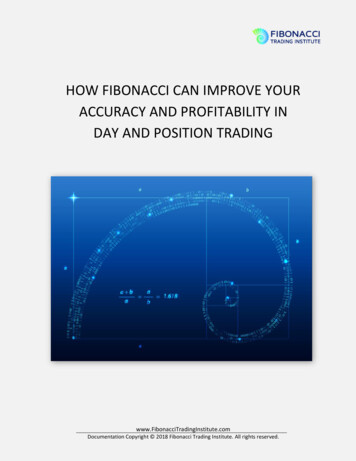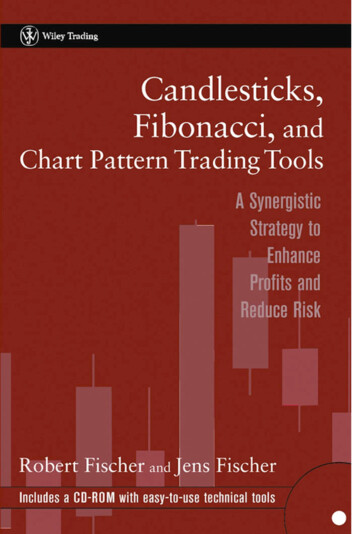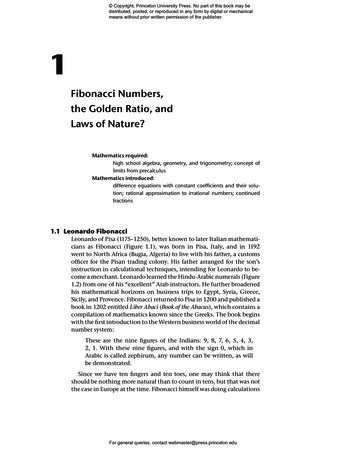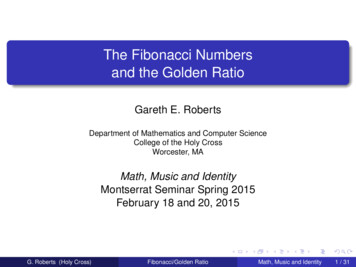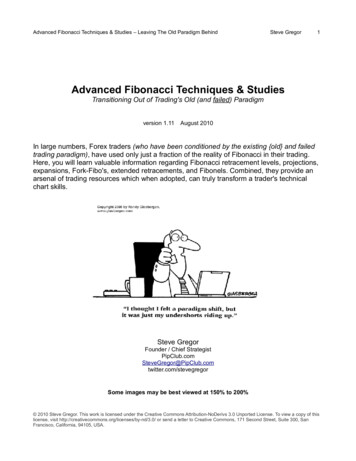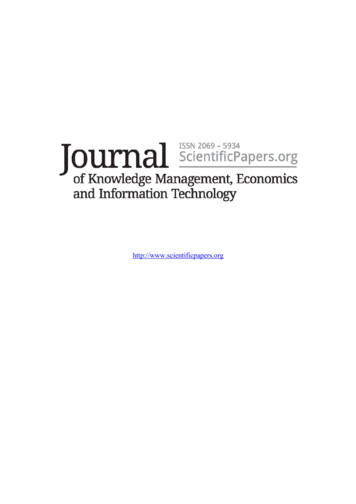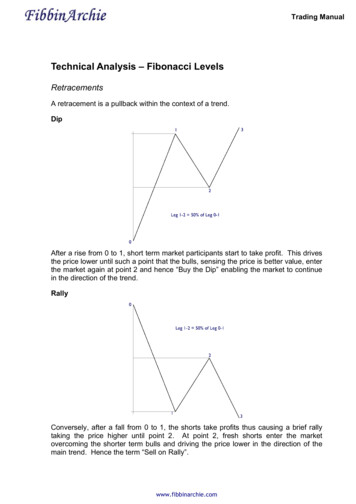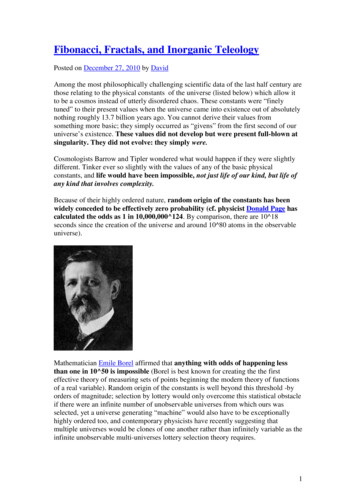
Transcription
Fibonacci, Fractals, and Inorganic TeleologyPosted on December 27, 2010 by DavidAmong the most philosophically challenging scientific data of the last half century arethose relating to the physical constants of the universe (listed below) which allow itto be a cosmos instead of utterly disordered chaos. These constants were “finelytuned” to their present values when the universe came into existence out of absolutelynothing roughly 13.7 billion years ago. You cannot derive their values fromsomething more basic; they simply occurred as “givens” from the first second of ouruniverse’s existence. These values did not develop but were present full-blown atsingularity. They did not evolve: they simply were.Cosmologists Barrow and Tipler wondered what would happen if they were slightlydifferent. Tinker ever so slightly with the values of any of the basic physicalconstants, and life would have been impossible, not just life of our kind, but life ofany kind that involves complexity.Because of their highly ordered nature, random origin of the constants has beenwidely conceded to be effectively zero probability (cf. physicist Donald Page hascalculated the odds as 1 in 10,000,000 124. By comparison, there are 10 18seconds since the creation of the universe and around 10 80 atoms in the observableuniverse).Mathematician Emile Borel affirmed that anything with odds of happening lessthan one in 10 50 is impossible (Borel is best known for creating the the firsteffective theory of measuring sets of points beginning the modern theory of functionsof a real variable). Random origin of the constants is well beyond this threshold -byorders of magnitude; selection by lottery would only overcome this statistical obstacleif there were an infinite number of unobservable universes from which ours wasselected, yet a universe generating “machine” would also have to be exceptionallyhighly ordered too, and contemporary physicists have recently suggesting thatmultiple universes would be clones of one another rather than infinitely variable as theinfinite unobservable multi-universes lottery selection theory requires.1
Many physicists and philosophers have been attracted to similar arguments in the lastthirty years (during which the ramifications of the delicately balanced physicalconstants first came to our attention; cf. the lecture by Dr. Francis Collins (PhD, &MD), first and long-time director of the Human Genome Project, here. Collins’ PhDis in Quantum Mechanics, though his focus now is on genetics). It was this issuewhich former leading atheist and world famous philosopher Antony Flew cited asconvincing him to abandon atheism for belief in God (many atheists claim it wasrather because Flew must have become senile!).Contemporary thinkers who remain atheists attempt to escape this conundrum in theonly way left to them: they postulate a hypothetical infinite number of unobservableuniverses from which a highly ordered one could have been a random occurrence.Contemporary atheism is thus forced to argue for the actuality of an essentially zeroprobability event by postulating something in principle unobservable (nonscientific/metaphysical).“‘I can’t believe that!’ said Alice. ‘Can’t you?’ the Queen said in a pitying tone. ‘Tryagain: draw a long breath, and shut your eyes.’ Alice laughed. ‘There’s no usetrying,’ she said: ‘one can’t believe impossible things.’ ‘I daresay you haven’t hadmuch practice, said the Queen. ‘When I was your age, I always did it for half-an-houra day. Why, sometimes I believed as many as six impossible things before breakfast.’”-Lewis Carroll, Through the Looking GlassThe slightest alteration of the following physical constants would result in a universeincapable of supporting life -not just life of our kind, but life of any kind that involvescomplexity, and in a universe that would be chaos rather than cosmos:Gravitational Coupling ConstantStrong Nuclear Force Coupling ConstantWeak Nuclear Force Coupling ConstantElectromagnetic Coupling ConstantRatio of Protons to ElectronsRatio of Electron to Proton MassExpansion Rate of the UniverseEntropy Level of the UniverseMass of the UniverseUniformity of the UniverseStability of ProtonsFine Structure ConstantsVelocity of LightDistance Between StarsRate of Luminosity of Stars8Be, 12C, and 4He Nuclear Energy Levels.An infinite number of unobservable universes -even were it the case- would not, ofcourse, necessarily “belong” to our atheist friends who need it so badly to account forzero probability of random origin of the universe’s physical constants at singularity;in fact it would be a perfect case scenerio of the ancient Augustinian cosmologicaltheodicy of pleroma, which posited all possible varieties and ranges of entities might2
actually exist; we will leave that subject for a possible future post; let us now movealong to consider the central topic of this essay.B. FRACTAL GEOMETRY: ON FINDING ORDER IN UNEXPECTEDPLACESIn what follows, we will explore one of the most astonishing and brilliant discoveriesof the last century. Although initially a mathematical discovery, its implications canbe seen to permeate our cosmos from the microsphere to the macrosphere to a degreethat is nothing less than mind-boggling, in a manner that was utterly unknown just afew decades ago.“This is how God created a system that gave us free will. It’s the most brilliantmaneuver in the universe, to create something in which everything is free! How couldyou do that?! exploring this set I certainly never had the feeling of invention. I hadnever the feeling that my imagination was rich enough to invent all the extraordinarythings. I was discovering them; they were there although no one had ever seen thembefore. It’s marvelous! A very simple formula describes all of these very complicatedthings. Who could have dreamed that such an incredibly simple equation could havegenerated images of literally infinite complexity? We’ve all read stories of maps thatrevealed the location of some hidden treasure. In this case the map is the treasure!” Benoit Mandelbrot, in Fractals: the Colors of Infinity (Arthur Clarke Documentary).Why do certain patterns (Fibonacci/fractal patterns) constantly reappearthroughout nature (organic and inorganic!) in phenomena as incredibly diverseas neuron firing patterns, trees and flowers, lightning, networks of veins in body,crystal structures, the inner structure of lungs, hearts, and other organs,hurricanes, spiral galaxies, viruses, most formations of plant life, cellularmicrotubules, chemical structures (e.g. platonic solids), family trees, snowflakes,3
even thoughts? (if you are not a mathematician or scientist, you will be able to morefully appreciate what all the things in this essay –indeed most things in our universehave in common after you watch the video which followsII. FRACTALS IN HUMAN PHYSIOLOGY (Yale University Biology Dept.)“Some of the most visually striking examples of fractal forms are found inphysiology: The respiratory, circulatory, and nervous systems are remarkableinstances of fractal architecture, branches subdividing and subdividing andsubdividing again. Nice pictures are provided in Goldberger, Rigney and West.Although no clear genetic, enzymic, or biophysical mechanism yet have been shownto be responsible for this fractal structure, few doubt this. Careful analysis of the lungsreveal fractal scaling, and it has been noted that this fractal structure makes the lungsmore fault-tolerant during growth. The heart is filled with fractal networks: thecoronary arteries and veins, the fibers binding the valves to the heart wall, the cardiacmuscles themselves, and the His-Purkinje system, etc.“In addition to falut-tolerance during growth, fractal branching makes available muchmore surface area for absorption and transfer in bronchial tubes, capallaries, intestinallining, and bile ducts. Kalda has proposed a fractal model of the blood vessel systemthat achieves a homogeneous oxygen supply throughout the body. Also, theredundancy of fractal structures make them robust against injury. For example, theheart can continue to function even after the His-Purkinje system has sufferedconsiderable damage. From his work on the ability of fractal drums to dampvibrations, Bernard Sapoval deduced another advantage of the fractal character of thecirculatory system: “the fractal structure of the human circulatory system damps outthe hammer blows that our heart generates.” “The heart is a very violent pump, and ifthere were any resonance in blood circulation, you would die.” Fractals may save ourlives every minute. Here are some casts of animal lungs. Finally, we note the bodyexhibits dynamical fractals. For example, it is well-known that healthy heartbeats arechaotic rather than regular. A careful plot of heart rates over several time scalesreveals self-similar scaling (Goldberger, Rigney and ology/Physiology/Physiology.html ; Onthe fractal nature of the human circulatory system, see here.III. BLOOD CELL DYNAMICS GOVERNED BY FIBONACCI RATIOS4
Blood cell dynamics are also governed by Fibonacci ratios:http://arxiv.org/abs/physics/0411169 “This paper demonstrates that the pattern of lipidspicules that emerge on the surface of red blood cells in the classic ‘Discocyte toEchinocyte’ shape change is a generative spiral, and presents a qualitative, fluiddriven mechanism for their production, compatible with the work of Douady andCouder. Implications for the dynamics of cell growth, plant cell phyllotaxy,programmed cell death and gravity sensitivity are explained in terms of a newqualitative model of cellular fluid dynamics.”IV. LEAVES, BRANCHES, FLOWERS, AND BASIC STRUCTURES OFPLANTSPlant Phylotaxis is the arrangement of plant elements as primordia on the shoot apex,e.g. branches, leaves, petals, stamens, sepals, florets, etc.).] The angle subtended at theapical center by two successive primordia is equal to the golden angle (137.5 degrees)in more than 90% of all plants studied worldwide. Such an arrangement allowsincorporate maximum packing efficiency for fruits and seeds, maximal access tosunlight by leaves, etc.See further at . INFORMATION ENCODING IN THE BRAIN5
Information encoding in the brain is also a Fibonacci process, as explained by HaraldWeiss and Volkmar Weiss, “The golden mean as clock cycle of brain waves” inChaos, Solitons & Fractals Volume 18, Issue 4, November 2003, Pages 643-652; cf.abstract and full article here; cf. also Weiss, Volkmar, “Memory Span as the Quantumof Action of Thought,” Cahiers de Psychologie Cognitive 14 (1995) 387-408 here.VI. THE FINE STRUCTURE CONSTANT AND THE STRUCTURE OFSPACE-TIMEThe fine structure constant and the structure of space are also according to Fibonacci.See Carlos Castro, “Fractal Strings as the Basis of Cantorian-Fractal Spacetime andthe Fine Structure Constant,” Chaos Solitons Fractals 14 (2002) 1341-1351 here.VII. FIBONACCI AND FRACTAL GEOMETRY: GENERALOBSERVATIONSAll fractal self-similar structures (whereupon parts resemble the whole object inshape) incorporate in their geometrical design numbers which are functions of thegolden mean.In case the reader is unfamiliar with fractal geometry, the relationship betweenFibonacci and fractals is illustrated simply in the photo above which shows phi (whichrepresents the average of the Fibonacci series) in the Mandelbrot set. The Mandelbrotset is used to generate fractals and fractal art. As anyone knows who has viewed thistype of art, amazingly complex and at the same time strikingly NATURE-LIKE andLIFE-LIKE PATTERNS (like insects, leaves, flowers, rock formations, faces, etc,)are quite common with the Mandelbrot “algorithm” (google fractal art!). Random6
generation is not contra “structure” given an algorithm which “guides” the unfolding;hence chance itself may be ‘governed’ in such a way as the gorgeous symphony oflife may still be to a degree “orchestrated”It is critically important to note that the “algorithm” which generates the ‘similarity ininfinite diversity’ we see in nature is not a specific number (phi), but a range ofFibonacci ratios, e.g. from 1/1, 2/1, 3/2, 5/3, 8/5, 13/8, 21/13, 32/21 and so oninfinitely. Phi, the average of these ratios, is not a ‘magic number,’ but merely theaverage of all such ratios. In nature it is not so much phi that is important as it is theSPECTRUM OR RANGE OF VALUES which phi may embody as an average. It isthe fact of a Fibonacci range rather than a specific uniform value that especiallyallows infinite diversity within the algorithmic similarity to be maximized. Thanks toGod not all flowers or faces look alike! It is the startling diversity of our universe, inspite of its unfolding within the fine-tuned confines of specific physical constants etc.that never fails to take our breath away.VIII. MAGNETIC FIELD BORDERS AND ELECTROMAGNETISM“Also Mandelbrot curves have been discovered in cross-sections of magnetic fieldborders, implying there is a 3-D mandelbrot equivalent that is closely tied toelectromagnetism and therefore a deep structural and fundamental aspect of life, andphysical space/time “ we see the Mandelbrot relationship to the period-doubling ‘chaos’ equation whichis used to describe population expansion, plant growth, weather instability and a hostof other physical processes. This relationship also has a habit of popping upunexpectedly in other dynamic non-linear equations (fractals made from Newtonsmethod of deriving a cube-root being the most obvious)“Think about that for a moment – Take any slice of the magnetic field of the earth,sun, a plant, the data on audio or video tape, and there is our old familiar Buddhalooking mandelbrot! This suggests an unknown, yet-to-be-clarified fundamentalimportance of the Mandelbrot Set in many physical processes. Clearly this issomething far more significant than a means of generating visually pleasantmathematical abstractions.“Many things previously called chaos are now known to follow subtle fractal laws ofbehavior. So many things turned out to be fractal that the word “chaos” itself (inoperational science) had to be formally defined as following inherently unpredictable7
yet generally deterministic rules based on nonlinear iterative equations. Fractals areunpredictable in specific details yet deterministic when viewed as a total pattern – inmany ways this reflects what we observe in the small details & total pattern of life inall it’s physical and mental varieties, too .”http://www.miqel.com/fractals math patterns/visual-math-mandelbrot-magic.htmlIX. NANOTECH BOMBSHELL: RANDOM MOTION OF FERROFLUIDDROPLETS ON SILICONPhysicists, Stéphane Douady and Yves Couder from the Laboratory for StatisticalPhysics in Paris in 1992 demonstrated tiny magnetized ferrofluid droplets in pool ofsilicone oil ultimately form spirals described by the golden angle (see the video here;an abstract in Physical Review (Douady, S. and Y. Couder. 2002. “Phyllotaxis as aphysical self-organized growth process,” Physical Review Letters 68 (March30):2098-2101) can be found here).X. FIBONACCI AND THE HUMAN FORM: ADDITIONALOBSERVATIONS8
We have already seen the amazing extent to which Fibonacci inform us about ourneural structure, thought structure, organ structure, blood dynamics, circulatorysystem, etc. etc.; the golden ratio also explains human perceptions of beauty to thedegree that standard practice for plastic surgeons and dentists is to carefully employthese ratios in reconstruction of the face and teeth, branching patterns and proportionsof skeletal structure, and many other applications beyond the scope of this brief essay.XI. A “DNA” DOUBLE HELIX NEAR THE CENTER OF THE MILKYWAY?!!In March of 2006, an incredible news story was released about a double helix nebulafound near the center of the Milky Way. “We see two intertwining strands wrappedaround each other as in a DNA molecule,” said Mark Morris, a UCLA professor ofphysics and astronomy, and lead author. “Nobody has ever seen anything like thatbefore in the cosmic realm. Most nebulae are either spiral galaxies full of stars orformless amorphous conglomerations of dust and gas — space weather. What we seeindicates a high degree of order.” See the original article at the UCLA website here.The double helix, mysteriously mirrored in the stars and the DNA of living creatures,is another Fibonacci structure:9
XII. ANCIENT ISRAEL’S HOLY ARK OF THE COVENANT AND BRAZENALTARIntriguing also is the presence of this precise ratio in the Tabernacle of Israel. If it wasonly there once, it would be more reasonable to attribute its presence to chance, andwe are reminded of the exhortation to Moses to ensure he adhered exactly to theheavenly pattern (cited below). This “signature literally written all across the face ofthe cosmos” appears in two critically important structures which have differentdimensions, in the most important artifacts known to ancient Judaism: the Holy Arkof the Covenant, and the Brazen Altar where all Israel’s sacrificial offerings werebrought.2.5/1.5 1.6666667 ( 5/3)Exodus 25:10:”And they shall construct an ark of acacia wood two and a half cubitslong, and one and a half cubits wide, and one and a half cubits high.”5/3 1.6666667Exodus 27:1: “And you shall make the altar of acacia wood, five cubits long and fivecubits wide; the altar shall be square, and its height shall be three cubits”Exodus 25:40: “And see that you make them after the pattern for them, whichwas shown to you on the mountain.”If one already considers Christian theism of reasonable warrant it becomes difficultnot to see the very signature of God in almost every direction one can possibly look from the heavens to the mirror.10
XIII. LARGE SCALE STRUCTURE OF THE UNIVERSE, AND NEURALCONNECTIONSFrom Constantine, David, “They Look Alike, but There’s a Little Matter of Size”(New York Times, Aug 15, 2006): “One is only micrometers wide. The other isbillions of light-years across. One shows neurons in a mouse brain. The other is asimulated image of the universe. Together they suggest the surprisingly similarpatterns found in vastly different natural phenomena. Mark Miller, a doctoral studentat Brandeis University, is researching how particular types of neurons in the brain areconnected to one another. By staining thin slices of a mouse’s brain, he can identifythe connections visually. The image (below left) shows three neuron cells on the left(two red and one yellow) and their connections. An international group ofastrophysicists used a computer simulation last year to recreate how the universe grewand evolved. The simulation image (below right) is a snapshot of the present universethat features a large cluster of galaxies (bright yellow) surrounded by thousands ofstars, galaxies and dark matter (web).” (Source by Mark Miller, Brandeis University;Virgo Consortium for Cosmological Supercomputer Simulations;http://www.visualcomplexity.com).How can the large scale structure of the universe and a mouse neuron have the samestructure? The degree to which the Fibonacci ratio is present in both inorganicstructures and the bodies of living beings suggests there is something more thangenetics and selection alone involved in the latter. Despite a stunning difference inscale there a key similarity: neural networks, like the fine structure of the universe, are(and the large scale structure of the universe) are fractal lications/Fractal-Neural-Networks.htm)XIV. WHAT DOES IT TAKE TO BUILD A WORLD?11
“What does it take to build a world? This is the central question of my research. Myoverarching goal is the creation from first algorithmic principles of an entire planet,well-defined everywhere and at all scales, with visual complexity, appearance, andbeauty similar to Earth, and to bring that model to real-time performance. Needless tosay, this undertaking subsumes a large number of interesting and challengingelements. These include developing our capabilities in visual realism, models ofnatural phenomena, computational efficiency in such models, and algorithmic art. Iam confident that there are enough challenges involved to keep me busy for the rest ofmy days.A planet, at the scales of ordinary human experience, is defined by its landscapes.Landscapes are in turn defined by the form of the land, the lighting, the current stateof the atmosphere, and by the life forms found within it. My research encompasses thefirst three, terrain, lighting, and atmospherics; peculiarities of taste and predilectionlead me to eschew modeling life forms, leaving them to others to perfect. There is noaccounting for taste, and “I love landscapes!” All successful synthetic terrainmodels for computer graphics are fractal: That is, they feature complexity resultingfrom the repetition of form over a variety of scales. The complexity resulting fromthis repetition of form over many scales leads to the odd idea of fractal dimension: aspatial dimension which is intermediate between the familiar integer-valued (i.e., 1, 2,and 3) dimensions we’re used to dealing with.”-Professor Ken Musgrave, Fall 1994 George Washington U. EECS le.html Dr. Musgrave works with BenoitMandelbrot, the discoverer of the Mandelbrot set.XV. SEASHELL STRUCTURE, PLANETARY ORBITS, AND SPIDER WEBS?All informed observers concede the undeniable and astonishing ubiquity of Fibonacciand fractals in nature. Even some basic natural phenomena which at first glance seemto depart from mathematization according to *phi* (an average of the ratios of theFibonacci series) can be found, upon closer analysis to contain more Fibonacci than isfirst apparent to the uncritical eye. As we have emphasized, it is the Fibonacci serieswhich is so prevalent in nature rather than *phi* (the average of said series) per se:phi is a mathematical abstraction of the range of things we see, it is but an average, ahuman methodological contrivance. There is an additional surprising point to considerregarding phenomena like seashells and planetary orbits, which are Fibonacci on themain, but with variations: the manner in which variation from Fibonacci occurs in12
e.g. seashells and planetary orbits actually itself algorithmic according to preciseFibonacci exponents (see www.spirasolaris.ca/llight.html)XVI. SOME SURPRISING CONCLUSIONSThere are some rather revolutionary conclusions from the recent revolution in fractalgeometry stemming from Mandelbrot’s great discovery. First, “chance” itself is“governed” algorithmically to an extent entirely unsuspected just a few decades ago.Yet this algorithmic “governance” is such that infinite variety is not precluded, butrather enabled! The centuries-old philosophical presupposition that chance andgovernance are opposite has been effectively demolished by Mandelbrot’s amazingdiscovery. It is also interesting that the discovery was initially within the realm ofpure mathematics, rather than the empirical (empirical, i.e. depending on sensoryobservation); as a video presented below emphasizes, some philosophers of sciencewho prefer to methodologically restrict the “scientific” to the directly observable in amanner similar to that of the Logical Positivists of the early 20th century resistedacknowledging the vast extent to which nature embodies this newly discovered fractalgeometry (the demarcation criterion between science and non-science is obviously ofcritical importance for the philosophy of science; significantly this issue has not beenresolved and may be irresolvable in principle (cf. the Kuhn-Popper debate andbeyond). Such skepticism, however, could not long survive decades of carefulmeasurement.Arthur C. Clark produced a fabulous series on fractals titled The Colors of Infinitywhich documents and describes all this and more, with interviews with suchluminaries as Benoit Mandelbrot (who discovered fractal geometry), StephenHawking, and many other great pioneers of fractal mathematical applications (thevideos are found below). We’ll close this brief essay with some fascinating quotationsfrom some of these men taken from part 5:“This is how God created a system that gave us free will. It’s the most brilliantmaneuver in the universe, to create something in which everything is free! How couldyou do that?!”“ Albert Einstein refused to accept the idea of a dice-playing deity. He wrote a letterto Max Borne in which he said ‘you believe in a dice-playing God; I believe incomplete law and order.’ So he obviously felt that chance and deterministic laws werenot compatible and he preferred the deterministic laws. Now what the Mandelbrot setand Chaos and related things have done for us is to show that you can have both at thesame time. So it is not whether God plays dice that matters, it’s how God plays dice.”“I [Benoit Mandelbrot] can tell you exploring this set I certainly never had the feelingof invention. I had never the feeling that my imagination was rich enough to invent allthe extraordinary things. I was discovering them, they were there although no one hadever seen them before.” It’s marvelous! A very simple formula describes all of thesevery complicated things ” “Who could have dreamed that such an incredibly simpleequation could have generated images of literally infinite complexity? We’ve all readstories of maps that revealed the location of some hidden treasure. In this case themap is the treasure!” -from Fractals: The Colors of Infinity13
14
2010 by katachriston.wordpress.com (text)http://katachriston.wordpress.com/15
Fibonacci and fractals is illustrated simply in the photo above which shows phi (which represents the average of the Fibonacci series) in the Mandelbrot set. The Mandelbrot set is used to generate fractals and fractal art. As anyone knows who has viewed this type of art, amazingl

